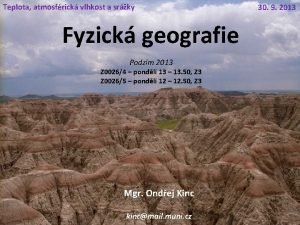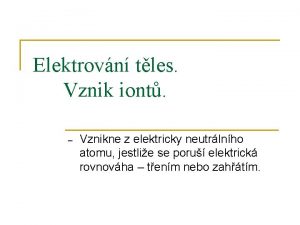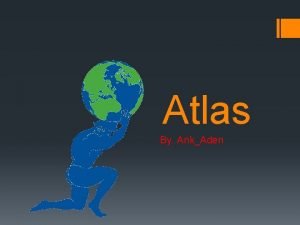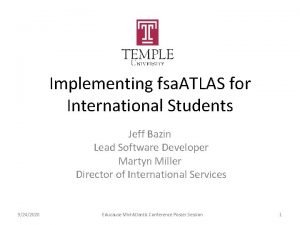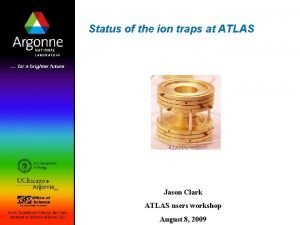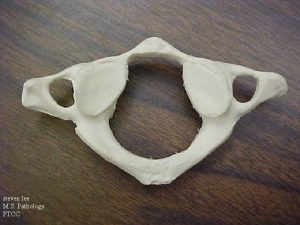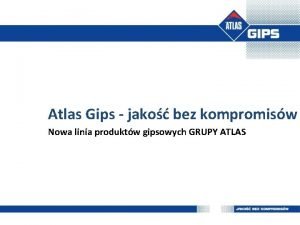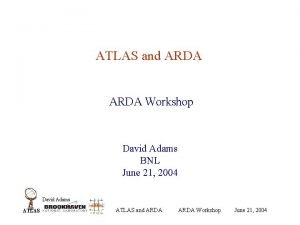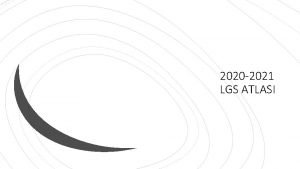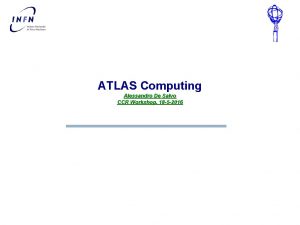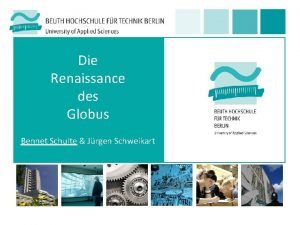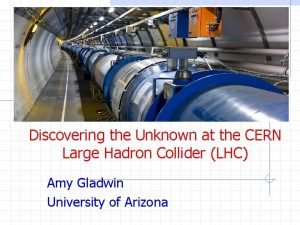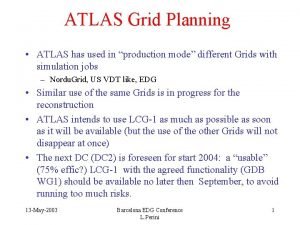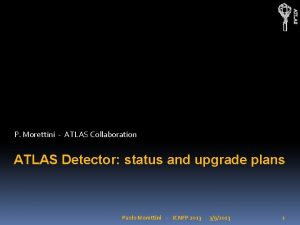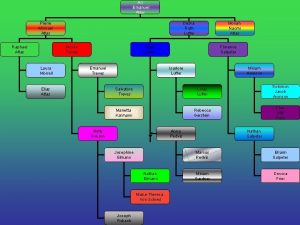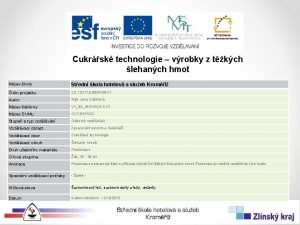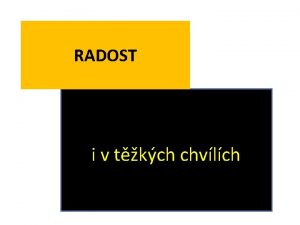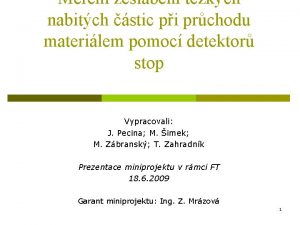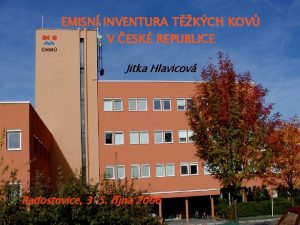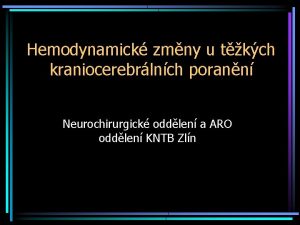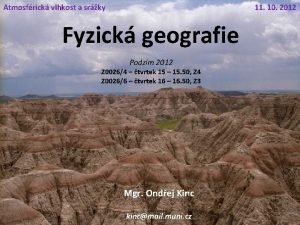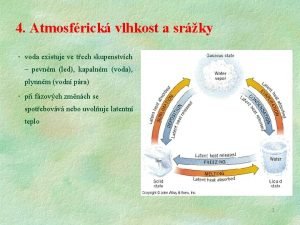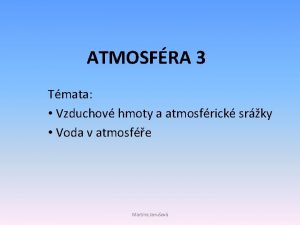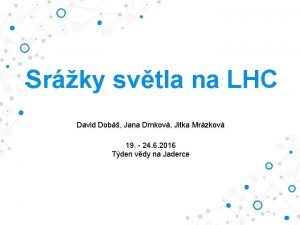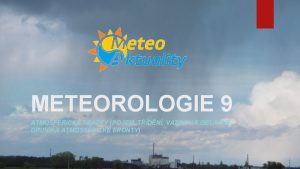Srky tkch iont v detektoru ATLAS Martin Spousta


































- Slides: 34

Srážky těžkých iontů v detektoru ATLAS Martin Spousta, UČJF, MFF UK 10. 9. 2009 Martin Spousta Charles University in Prague

Motivation • • • Main task is to better understand QCD at high temperature where quarks and gluons are deconfined. In this limit strong interactions can possibly exhibit unexpected characteristics that do not follow from perturbative considerations. One of useful tools are jets - jet quenching predicted in early 90’s and observed at RHIC experiments. 10. 9. 2009 Martin Spousta Charles University in Prague 2

Motivation The main results concerning high-p. T probes from RHIC experiments: • • High p. T hadrons are suppressed by a factor of ~5 compared to binary scaled p+p. Away side peak is completely absent in di-jet correlation measurements. Measured spectra obey power-law behavior characteristic for p. QCD processes. . Energy loss is a final state effect, not an initial state effect. Energy loss is at the parton level, not at the hadron level. Partons lose their energy dominantly by the radiative energy loss, collisional energy loss may be important only for heavy quarks. Partons lose 1 -10 Ge. V/fm 3 in the created medium. This energy loss seems to depend linearly on the path-length traveled through the expanding medium. 10. 9. 2009 Martin Spousta Charles University in Prague 3

Motivation • Jets copiously produced at LHC energies possibility to study details of energy loss mechanism in QGP medium • Models and predictions for LHC energies exist but the details of QCD energy loss mechanisms in medium not well understood I. Vitev, et al. – modification of jet shapes 10. 9. 2009 N. Armesto, et al. – modification of fragmentation functions Martin Spousta Charles University in Prague 4

Why ATLAS? jet reconstruction using calorimeter, full azimuth, 10 units of pseudorapidity first layer of LAr EM calorimeter excellent for photon isolation, other layers also well segmented 10. 9. 2009 tracking in 2 T solenoid – fragmentation studies Martin Spousta Charles University in Prague 5

Jet reconstruction strategy PYTHIA dijets embedded to the unquenched HIJING events one event before the background subtraction one event after the background subtraction Cone jet reconstruction: • regions of interest found (seed regions) – fast sliding window algorithm used • background computed • excluding the seed-regions • vs. h, vs. layer • background subtracted • standard p+p jet finding algorithm used (seeded iterative R=0. 4 cone algorithm) An alternative: k. T-algorithm based reconstruction strategy – also studied 10. 9. 2009 Martin Spousta Charles University in Prague 6

Jet energy resolution stochastic term Fitting well known formula: noise term to p+p and Pb+Pb energy resolution constant term p+p Pb+Pb d. N/dh~2700 • Jet energy resolution bellow 25% for 70 Ge. V jets in the most central collisions (d. N/dh~2700 b=2 fm, unquenched HIJING) • Irreducible background fluctuations: ~ 15 Ge. V / jet 10. 9. 2009 Martin Spousta Charles University in Prague 7

Jet position resolution Tower size Pb+Pb d. N/dh~2700 • Jet position resolution in f similar to that in h (full field simulated) • It proves with increasing jet energy, in the whole energy range jet position resolution is within a half of a tower 10. 9. 2009 • Jet position resolution can be improved using a method of smaller cones: jet axis of a reconstructed jet is substituted by the jet axis from jet reconstructed with R<Rorig Martin Spousta Charles University in Prague 8

Efficiency and fake-rate • Efficiency is almost centrality independent – easier interpretation of jet properties vs. centrality • Above 70 Ge. V the efficiency is above 90% • Above 70 Ge. V very low fake rate < 5% (without any fake rejection) 10. 9. 2009 Martin Spousta Charles University in Prague 9

Comparison among jet finding algorithms • k. T algorithm exhibits serious problems with the jet energy scale: for more severe background, k. T underestimates the jet energy. This is due to the fact that k. T preferably clusters the softer part of a jet with the background k. T • Problematic algorithms: jet energy - k. T algorithm, size of the scale - Cambridge/Aachen fluctuations in bkgr • Non-problematic: - anti-k. T algorithm, - (ATLAS) cone algorithm • Difference among algorithms should be studied with real data (real jets & real noise) x favoured strategy 20% of ATLAS is to rely on one underestimation (max. two) jet algorithms! mean bkgr Et 10. 9. 2009 Martin Spousta Charles University in Prague 10

Comparison among jet finding algorithms Area of jets delivered by different algorithms is very different in the noisy environment k. T algorithm, D=0. 4 10. 9. 2009 the same event Martin Spousta Charles University in Prague anti-k. T algorithm, D=0. 4 11

Fragmentation function and j. T ○ - truth ● - reconstructed (jet ET 70 -140 Ge. V) j. T (Ge. V) Reconstruction procedure: • tracks are matched to calorimeter towers of a jet • j. T and z for tracks above 2 Ge. V is computed • background distributions of j. T and z are computed using tracks that match with HIJING particles, these distributions are subtracted, correction for the jet position resolution is applied j. T z … we can well reproduce j. T distribution and fragmentation function 10. 9. 2009 Martin Spousta Charles University in Prague 12

Fragmentation function and j. T from PYQUEN – reconstructed ○ - quenched ● - non-quenched (reconstructed) j. T (Ge. V) Large j. T suppressed gluons radiated from large angles Low z enhanced, higher z suppressed leading particle suppressed, redistribution of energy out of a jet core … if the quenching is of that order we should be able to measure it 10. 9. 2009 Martin Spousta Charles University in Prague 13

Jet shapes • Measure the energy flow inside the jet at the calorimeter level • Well defined in QCD, measured at Tevatron jet axis . . . integral jet shape. . . differential jet shape 10. 9. 2009 Martin Spousta Charles University in Prague 14

Problems of jet shapes 1. Effect of the calorimeter 2. Effect of the background (only applying subtraction is not enough) How to match “closed” to “open”? Better estimation of the jet position Deconvolution 10. 9. 2009 Martin Spousta Charles University in Prague 15

Problems of jet shapes Deconvolution: Bayesian unfolding 10. 9. 2009 Better estimation of the jet position: using the method of smaller cones Martin Spousta Charles University in Prague 16

Jet shapes from PYQUEN – reconstructed ○ - non-quenched ● - quenched (reconstructed events) • Result at the after the reconstruction • Jet quenching effect still well visible … if the quenching is of that order we should be able to measure it 10. 9. 2009 Martin Spousta Charles University in Prague 17

Complementary quantities to measure different energy loss mechanisms jet shape PYQUEN with only radiative energy loss PYQUEN with only collisional energy loss 10. 9. 2009 ○ - non-quenched ● - quenched jet shape ○ - non-quenched ● - quenched Martin Spousta Charles University in Prague jet energy spectrum x - non-quenched x - quenched 18

Summary • We didn’t talk about: – di-jet azimuthal correlations – g-jet correlations – p. OUT, radial moments, . . . all these quantities can be used to distinguish different energy loss scenarios. • ATLAS is very good detector for the jet heavy ion physics (it is also good detector for soft heavy ion physics, quarkonia, and other important measurements). • We have in our hands tools for reconstruction and analysis of heavy ion data. • Bearing in mind that p+p with full luminosity is expected to be similar to peripheral Pb+Pb collisions, we can say that these tools could be useful also for p+p measurements. 10. 9. 2009 Martin Spousta Charles University in Prague 19

Backup slides 10. 9. 2009 Martin Spousta Charles University in Prague 20 Backup slides

Backup slides Path integral in opacity (ASW) Gluon energy spectrum can be computed in 2 limits: w=x. E, k. T E, Q 2 (1 -x)E - few hard scatterings (GLV) - many soft scatterings (BDMPS) Other approaches: Higher Twists (direct computation of fragmentation function – formally similar to DGLAP), Finite Temperature approach (AMY), techniques which use Ad. S/CFT correspondence l L 10. 9. 2009 Martin Spousta Charles University in Prague 21 Backup slides

Backup slides: g-isolation single p 0 single g p 0 gg p 0 in Pb. Pb g in Pb. Pb (d. N/dh = 2700) 10. 9. 2009 Martin Spousta Charles University in Prague p 0 gg (d. N/dh = 2700) 22 Backup slides

Backup slides: g-isolation • can benefit from excellent longitudinal segmentation (0. 003 for the first sampling of EMCAL) • a set of cuts to distinguish a direct photons from neutral hadrons – based on the shower shape • double peaked or wide showers rejected • the most important cuts: − the fraction of energy in 8 strips around the core of 6 strips − energy of second peak minus the minimum energy between the two peaks 10. 9. 2009 Martin Spousta Charles University in Prague 23 Backup slides

Backup slides: g-jet correlations • g-jet correlation measurements can help jet analysis at low ET, can be used for the fake rejection • important for in-medium fragmentation studies 10. 9. 2009 Martin Spousta Charles University in Prague 24 Backup slides

Backup slides: tracking performance 10. 9. 2009 Martin Spousta Charles University in Prague 25 Backup slides

Backup slides: tracking efficiency Tracking efficiency ~ 70% for the most central collisions 10. 9. 2009 Martin Spousta Charles University in Prague 26 Backup slides

Backup slides: jet’s tracks Shape of the jet from tracking 10. 9. 2009 Martin Spousta Charles University in Prague 27 Backup slides

Backup slides: fake jet rejection 10. 9. 2009 Martin Spousta Charles University in Prague 28 Backup slides

Backup slides: Sensitivity to the jet position ○ - truth ● - reconstructed jet ET 70 -140 Ge. V Background distributions subtracted but the correction on the jet position resolution not applied => visible underestimation at small j. T (z is not affected much by the jet position resolution). Discrepancy can be removed using jet position determined by the cone reconstruction with smaller R. 10. 9. 2009 Martin Spousta Charles University in Prague 29 Backup slides

Backup slides: PYQUEN simulations - ratios illustration … nonquenched j. T quenched z quenched to non-quenched ratio 10. 9. 2009 Martin Spousta Charles University in Prague j. T z quenched to non-quenched ratio 30 Backup slides

Fragmentation function and j. T from PYQUEN – generator level ○ - quenched ● - non-quenched (simulated events) j. T (Ge. V) Large j. T suppressed gluons radiated from large angles Low z enhanced, higher z suppressed leading particle suppressed, redistribution of energy out of a jet core • Result at the generator level • PYQUEN settings: default setting for quenching, b=0, p. T, min=70 Ge. V, Pb. Pb, LHC energy 10. 9. 2009 Martin Spousta Charles University in Prague 31 Backup slides

Jet shapes from PYQUEN – generator level ○ - non-quenched ● - quenched (simulated events) • Result at the generator level • Almost factor of two in the jet core • Differential jet shape can show better the flow of the energy – energy is redistributed out of center of the jet 10. 9. 2009 Martin Spousta Charles University in Prague 32 Backup slides

Fast k. T jet reconstruction strategy k. T algorithm i j … reconstructs jets backwards along fragmentation chain k. T jet reconstruction: • run fast k. T algorithm • separate jet from the background • subtract background from jets • calibrate jet energy 10. 9. 2009 Martin Spousta Charles University in Prague 33 Backup slides

Backup slides 10. 9. 2009 Martin Spousta Charles University in Prague 34 Backup slides
 Srky
Srky Tles
Tles Ionty
Ionty Tkch
Tkch Wheat seeds atlas
Wheat seeds atlas Atlas software tutorial
Atlas software tutorial Atlas
Atlas Atlas trt
Atlas trt Perkiraan informasi berdasarkan judul buku atlas dunia
Perkiraan informasi berdasarkan judul buku atlas dunia National atlas of korea
National atlas of korea Atlas kanada
Atlas kanada Atlas estetika
Atlas estetika Géant atlas pointure
Géant atlas pointure Silvaco tcad
Silvaco tcad Dr jason atlas
Dr jason atlas Atlas cervical vertebrae
Atlas cervical vertebrae Florida breeding bird atlas
Florida breeding bird atlas Ajkd atlas of renal pathology
Ajkd atlas of renal pathology Fortis gk 2
Fortis gk 2 Contilube 2
Contilube 2 David arda
David arda Lgs atlas
Lgs atlas Volny.cz imap
Volny.cz imap Atlas sveta
Atlas sveta Arso atlas
Arso atlas Atlas ccr
Atlas ccr Language
Language Bennet schulte
Bennet schulte Atlas cern
Atlas cern Apofisis mamilar
Apofisis mamilar Anterior muscles of the leg
Anterior muscles of the leg Esqueleto equino
Esqueleto equino Atlas production schedule
Atlas production schedule Atlas.ti for mac
Atlas.ti for mac Atlas timi 51
Atlas timi 51
